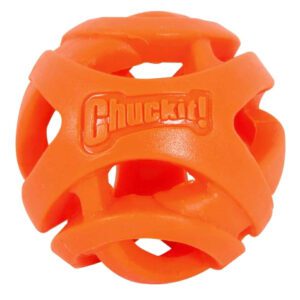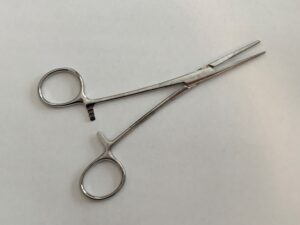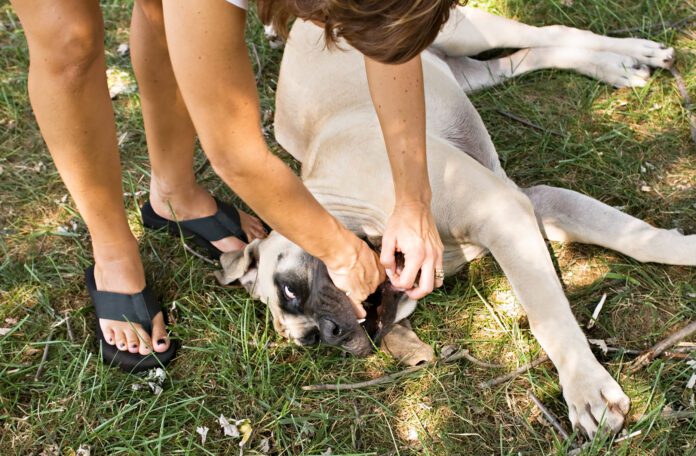Choking puts otherwise perfectly healthy dogs at an imminent risk of dying – within minutes – if first aid is not successful.
Choking is the inability to breathe due to an obstruction of the upper airway (trachea or windpipe) that blocks air flow. In dogs, choking is usually caused by foreign objects like balls or bones. Note: Trauma and swelling in the throat can also block air flow but require immediate veterinary help. The techniques below are used to remove the object stuck in the dog’s throat.
What to Do When a Dog Is Choking
If you encounter a choking dog, the first thing to do is ascertain if the dog is really choking. “Blocked air flow” is key here. If a dog can cough, there is airflow. So, if your dog is coughing, as harsh, uncomfortable, and scary as that may be, he is not choking. If coughing persists, he needs to see a veterinarian for sure, but you can relax and leave your superhero coat in the closet for now.
Signs of Choking in Dogs

Signs of choking in dogs include:
- Obvious distress
- Pawing at the mouth
- Gagging
- Trying to cough
- Producing no sounds, or just faint whistling sounds
- Salivating
- Tongue and gums turning blue
- Collapse
How to Save a Choking Dog
- Do a Finger Sweep Inside the Mouth
If you can safely put a finger in the dog’s mouth without being bitten, try a finger sweep first. If you can’t safely do this with a still conscious, panicking dog, it is the FIRST thing you do when they become unconscious. Be careful not to push anything you may feel at the back of the mouth deeper into the throat. If you feel something thin enough to grasp with your fingers, you may be able to retrieve it and clear the dog’s airway.
If you have a hemostat in your first-aid kit, you may be able to grasp the object. (A hemostat is a surgical tool normally used for clamping blood vessels, but its blunt end and grasping characteristics make it perfect for grabbing something heading down your dog’s throat.) If you feel something but can’t grasp it, your next move is to try to dislodge it by compressing the chest.

- Chest Compression
With the dog standing, stand over him facing the same way and with both hands simultaneously push on his rib cage. Strong, forceful, repeated thrusts will likely be required. If this is unsuccessful, move on to the Heimlich maneuver.
- The Heimlich maneuver
The way to do a Heimlich maneuver depends on the dog. The key is to use repeated, forceful, upward thrusts with a fist underneath the dog behind where the rib cage ends. Place yourself over the dog in whatever position allows you to place your hand/fist right below the rib cage and apply a maximum pressure gradient force from the abdomen/chest up toward the throat.
For small dogs, this position might be holding them with their spine against your body while applying the force.
For larger dogs, the Heimlich can be performed with them standing up on their hind legs, facing away from you (as is done with a human), or lying on their sides or backs if you can’t hold the dog up.
- Rescue Breathing
If you successfully dislodge the object, but your dog is not breathing, you must perform rescue breathing – like CPR for humans, as you’re administering artificial respiration – to get the dog breathing. Close the dog’s mouth, extend the neck, place your mouth over both nostrils to create a seal, and breathe hard enough into the dog to see the chest rise and fall. Wait a few seconds for a response and repeat as needed.
Prevent Choking in Dogs
Be careful with what you allow your dog to chew on and always supervise chewing sessions.
Choking occurs most commonly during play, especially with balls. Make sure your dog only plays with a safe type and size ball. A ball that is too small for the dog could easily make its way to the back of the throat and choke the dog. This is especially important in large exuberant dogs.
If the ball is compressible, like a tennis ball, it might be easier to retrieve if it becomes lodged. Balls with holes in them are even easier to grasp.
Warning: NEVER, EVER LET DOGS PLAY WITH LACROSSE BALLS! These balls are hard and dense and the most difficult, if not impossible, to retrieve when stuck in the back of the dog’s mouth.
If your dog is choking on a ball, a special technique called eXternal eXtraction Technique, or XXT, might work. Place the unconscious dog on his back, straddle the dog, and extend the dog’s neck. In this position, you will likely be able to see the bulge of the ball in the dog’s trachea Place your thumbs on either side of the trachea behind the ball, with your fingers grasping the dog’s jaw bones for purchase. Repeatedly push with your thumbs against the ball, in a down and forward (away from your body) direction. Think of it as a ball stuck in a garden hose; you are trying to push it out of the end of the hose with your thumbs.
See the video on this page to see this being done on an anatomical model of a dog.







To facilitate rescue breathing in a dog, along with a neck extension, their tongue must be pulled out of the mouth also (so it will be hanging out of their mouth). This opens the airway properly.
Thanks for this article…it may save a life!
A hemostat tool should be always in your First aid kit.
This happened to one of my dogs beagle/basset hound mix 33 pounds. After I handed out crunchy biscuits to my pack Gideon walked away from me walking side to side and thrusting his head forward…no sound. I got down on my knees to do the Heimlich on my deep chested dog….no success. I sat on a kitchen chair with my legs out straight I put him upside down….down my legs and pounded on him as hard as I could….the biscuit popped out. Gideon got up and walked away I collapsed on the floor sobbing….and called the vet and took him in for a check up. I was afraid that I had broken ribs or injured him in some way….but the vet said Gideon was OK. No more crunchy intact biscuits I hit them with a wooden kitchen mallet and broke them up from then on…..
Checking on-line for a hemostat, there are many different types available. I don’t have the knowledge to know which type to purchase. Can someone help me out with this by supplying a link or a link to Amazon. Many thanks.
https://www.amazon.com/HTS-161S2-Locking-Straight-Hemostat/dp/B000W1Y9YU/ref=sxin_15_ac_d_rm?ac_md=0-0-aGVtb3N0YXRzIGZvciBkb2dz-ac_d_rm_rm_rm&content-id=amzn1.sym.b09913c7-88ee-4b06-b977-3fd4ebd29a25%3Aamzn1.sym.b09913c7-88ee-4b06-b977-3fd4ebd29a25&crid=37VTRLK9D6YOC&cv_ct_cx=hemostats+for+dogs&keywords=hemostats+for+dogs&pd_rd_i=B000W1Y9YU&pd_rd_r=95dac996-8aad-4fbc-bba2-ce35c8cfcfe9&pd_rd_w=xF67M&pd_rd_wg=PuksN&pf_rd_p=b09913c7-88ee-4b06-b977-3fd4ebd29a25&pf_rd_r=RQ67FAWBX0DWNWTPG7MM&qid=1675369831&sprefix=hemos%2Caps%2C301&sr=1-1-7d9bfb42-6e38-4445-b604-42cab39e191b